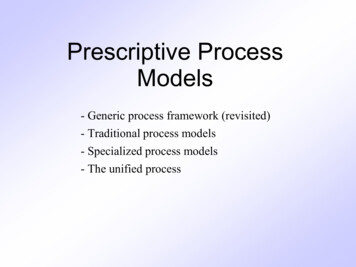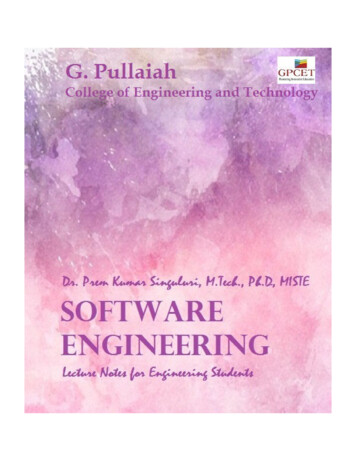
Transcription
Prescriptive ProcessModels- Generic process framework (revisited)- Traditional process models- Specialized process models- The unified process
Generic Process Framework Communication– Involves communication among the customer and other stake holders; encompassesrequirements gathering Planning– Establishes a plan for software engineering work; addresses technical tasks,resources, work products, and work schedule Modeling (Analyze, Design)– Encompasses the creation of models to better under the requirements and the design Construction (Code, Test)– Combines code generation and testing to uncover errors Deployment– Involves delivery of software to the customer for evaluation and feedback2
Modeling: Software RequirementsAnalysis Helps software engineers to better understand the problem they willwork to solve Encompasses the set of tasks that lead to an understanding of what thebusiness impact of the software will be, what the customer wants, andhow end-users will interact with the software Uses a combination of text and diagrams to depict requirements fordata, function, and behavior– Provides a relatively easy way to understand and review requirements forcorrectness, completeness and consistency3
Modeling: Software Design Brings together customer requirements, business needs, and technicalconsiderations to form the “blueprint” for a product Creates a model that that provides detail about software data structures,software architecture, interfaces, and components that are necessary toimplement the system Architectural design– Represents the structure of data and program components that are required to buildthe software– Considers the architectural style, the structure and properties of components thatconstitute the system, and interrelationships that occur among all architecturalcomponents User Interface Design– Creates an effective communication medium between a human and a computer– Identifies interface objects and actions and then creates a screen layout that formsthe basis for a user interface prototype Component-level Design– Defines the data structures, algorithms, interface characteristics, and communicationmechanisms allocated to each software component4
Traditional Process Models
Prescriptive Process Model Defines a distinct set of activities, actions, tasks, milestones, and workproducts that are required to engineer high-quality software The activities may be linear, incremental, or evolutionary6
Waterfall Model(Diagram)CommunicationProject nCodeTestDeploymentDeliverySupportFeedback7
Waterfall Model(Description) Oldest software lifecycle model and best understood by upper management Used when requirements are well understood and risk is low Work flow is in a linear (i.e., sequential) fashion Used often with well-defined adaptations or enhancements to currentsoftware8
Waterfall Model(Problems) Doesn't support iteration, so changes can cause confusion Difficult for customers to state all requirements explicitly and up front Requires customer patience because a working version of the programdoesn't occur until the final phase Problems can be somewhat alleviated in the model through the addition offeedback loops (see the next slide)9
Waterfall Model with Feedback(Diagram)CommunicationProject nCodeTestDeploymentDeliverySupportFeedback10
Incremental Model(Diagram)Increment entIncrement entIncrement ent11
Incremental Model(Description) Used when requirements are well understood Multiple independent deliveries are identified Work flow is in a linear (i.e., sequential) fashion within an increment and isstaggered between increments Iterative in nature; focuses on an operational product with each increment Provides a needed set of functionality sooner while delivering optionalcomponents later Useful also when staffing is too short for a full-scale development12
Prototyping ingQuick DesignDeployment,Delivery,and FeedbackConstructionOf Prototype13
Prototyping Model(Description) Follows an evolutionary and iterative approach Used when requirements are not well understood Serves as a mechanism for identifying software requirements Focuses on those aspects of the software that are visible to the customer/user Feedback is used to refine the prototype14
Prototyping Model(Potential Problems) The customer sees a "working version" of the software, wants to stop alldevelopment and then buy the prototype after a "few fixes" are made Developers often make implementation compromises to get the softwarerunning quickly (e.g., language choice, user interface, operating systemchoice, inefficient algorithms) Lesson learned– Define the rules up front on the final disposition of the prototype before it is built– In most circumstances, plan to discard the prototype and engineer the actualproduction software with a goal toward quality15
Spiral artDeploymentConstruction16
Spiral Model(Description) Invented by Dr. Barry Boehm in 1988 while working at TRWFollows an evolutionary approachUsed when requirements are not well understood and risks are highInner spirals focus on identifying software requirements and project risks; mayalso incorporate prototypingOuter spirals take on a classical waterfall approach after requirements have beendefined, but permit iterative growth of the softwareOperates as a risk-driven model a go/no-go decision occurs after eachcomplete spiral in order to react to risk determinationsRequires considerable expertise in risk assessmentServes as a realistic model for large-scale software development17
General Weaknesses ofEvolutionary Process Models1)2)Prototyping poses a problem to project planning because of the uncertainnumber of iterations required to construct the productEvolutionary software processes do not establish the maximum speed ofthe evolution 3)If too fast, the process will fall into chaosIf too slow, productivity could be affectedSoftware processes should focus first on flexibility and extensibility, andsecond on high quality We should prioritize the speed of the development over zero defectsExtending the development in order to reach higher quality could result inlate delivery18
Specialized Process Models
Component-based Development Model Consists of the following process steps– Available component-based products are researched and evaluated for theapplication domain in question– Component integration issues are considered– A software architecture is designed to accommodate the components– Components are integrated into the architecture– Comprehensive testing is conducted to ensure proper functionality Relies on a robust component library Capitalizes on software reuse, which leads to documented savings inproject cost and time20
Formal Methods Model(Description) Encompasses a set of activities that leads to formal mathematicalspecification of computer software Enables a software engineer to specify, develop, and verify acomputer-based system by applying a rigorous, mathematical notation Ambiguity, incompleteness, and inconsistency can be discovered andcorrected more easily through mathematical analysis Offers the promise of defect-free software Used often when building safety-critical systems21
Formal Methods Model(Challenges) Development of formal methods is currently quite time-consuming andexpensive Because few software developers have the necessary background toapply formal methods, extensive training is required It is difficult to use the models as a communication mechanism fortechnically unsophisticated customers22
The Unified Process
Background Birthed during the late 1980's and early 1990s when object-orientedlanguages were gaining wide-spread use Many object-oriented analysis and design methods were proposed;three top authors were Grady Booch, Ivar Jacobson, and JamesRumbaugh They eventually worked together on a unified method, called theUnified Modeling Language (UML)– UML is a robust notation for the modeling and development of objectoriented systems– UML became an industry standard in 1997– However, UML does not provide the process framework, only thenecessary technology for object-oriented development24
Background (continued) Booch, Jacobson, and Rumbaugh later developed the unified process,which is a framework for object-oriented software engineering usingUML– Draws on the best features and characteristics of conventional softwareprocess models– Emphasizes the important role of software architecture– Consists of a process flow that is iterative and incremental, therebyproviding an evolutionary feel Consists of five phases: inception, elaboration, construction, transition,and production25
Phases of the Unified Transition26
Inception Phase Encompasses both customer communication and planning activities of thegeneric process Business requirements for the software are identified A rough architecture for the system is proposed A plan is created for an incremental, iterative development Fundamental business requirements are described through preliminary usecases– A use case describes a sequence of actions that are performed by a user27
Elaboration Phase Encompasses both the planning and modeling activities of the generic process Refines and expands the preliminary use cases Expands the architectural representation to include five views–––––Use-case modelAnalysis modelDesign modelImplementation modelDeployment model Often results in an executable architectural baseline that represents a first cutexecutable system The baseline demonstrates the viability of the architecture but does not provideall features and functions required to use the system28
Construction Phase Encompasses the construction activity of the generic process Uses the architectural model from the elaboration phase as input Develops or acquires the software components that make each use-caseoperational Analysis and design models from the previous phase are completed to reflect thefinal version of the increment Use cases are used to derive a set of acceptance tests that are executed prior tothe next phase29
Transition Phase Encompasses the last part of the construction activity and the first part of thedeployment activity of the generic process Software is given to end users for beta testing and user feedback reports ondefects and necessary changes The software teams create necessary support documentation (user manuals,trouble-shooting guides, installation procedures) At the conclusion of this phase, the software increment becomes a usablesoftware release30
Production Phase Encompasses the last part of the deployment activity of the generic processOn-going use of the software is monitoredSupport for the operating environment (infrastructure) is providedDefect reports and requests for changes are submitted and evaluated31
Unified Process Work Products Work products are produced in each of the first four phases of theunified process In this course, we will concentrate on the analysis model and thedesign model work products Analysis model includes– Scenario-based model, class-based model, and behavioral model Design model includes– Component-level design, interface design, architectural design, anddata/class design32
which is a framework for object-oriented software engineering using UML -Draws on the best features and characteristics of conventional software process models -Emphasizes the important role of software architecture -Consists of a process flow that is iterative and incremental, thereby providing an evolutionary feel











